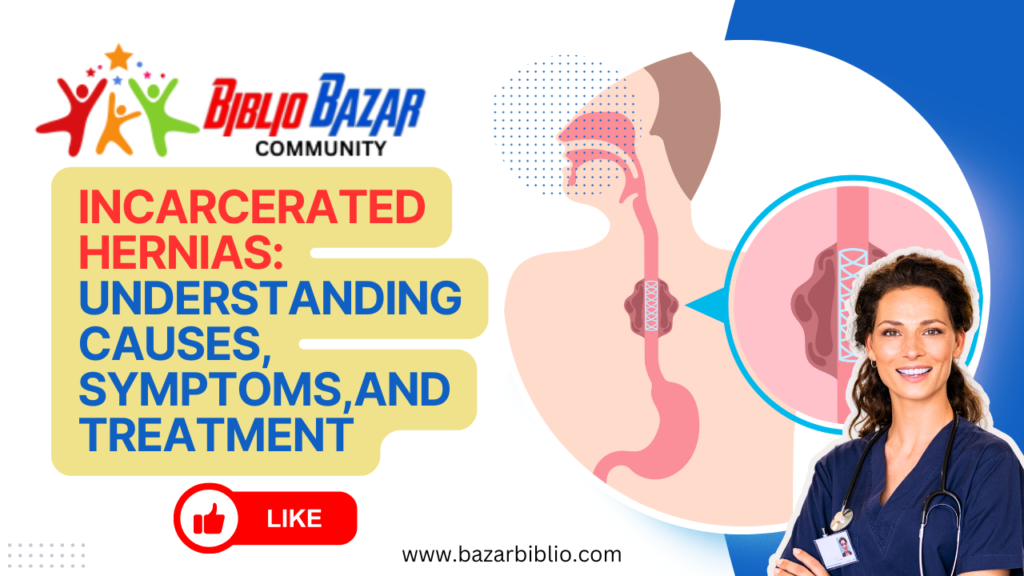
An incarcerated hernia is a serious medical condition that occurs when a part of the intestine or abdominal tissue becomes trapped in a hernia sac and cannot return to its original position. This can lead to a potentially life-threatening complication known as strangulation, where the blood supply to the trapped tissue is cut off, causing tissue death. It’s crucial to understand the types, causes, risk factors, symptoms, and treatment options for incarcerated hernias to ensure prompt medical attention and appropriate care.
Types of hernias that can become incarcerated include inguinal, femoral, umbilical, and incisional hernias. Each of these types involves a different part of the abdominal wall or groin. Inguinal hernias are the most common, occurring in the groin area, while femoral hernias appear just below the groin. Umbilical hernias occur near the navel, and incisional hernias can develop at the site of a previous surgical incision.

The primary cause of an incarcerated hernia is a combination of muscle weakness and strain. Factors that can contribute to this include heavy lifting, obesity, chronic coughing, or constipation. These activities and conditions increase the pressure on the abdominal wall, potentially leading to the development or worsening of a hernia.
Certain risk factors make some individuals more susceptible to incarcerated hernias. Age is a significant factor, with older adults being more prone to hernias. A history of hernias or previous surgeries increases the likelihood of developing an incarcerated hernia. Additionally, conditions that elevate abdominal pressure, such as chronic obstructive pulmonary disease (COPD) or pregnancy, also heighten the risk.

Recognizing the symptoms of an incarcerated hernia is vital for seeking timely medical intervention. Symptoms include sudden, severe pain at the hernia site, nausea, vomiting, and an inability to pass gas or have a bowel movement. The hernia bulge may become tender, swollen, and non-reducible, meaning it cannot be pushed back into the abdomen. These signs necessitate immediate medical attention.
Treatment for an incarcerated hernia typically involves surgery, as this condition is a medical emergency. Non-surgical methods, such as manual reduction, are rarely successful and not recommended due to the risk of strangulation. Surgical intervention aims to release the trapped tissue and restore normal blood flow. The surgery can be performed using either open or laparoscopic techniques, depending on the hernia type and the patient’s condition.

Surgical management includes open hernia repair or laparoscopic repair. Open hernia repair involves making an incision near the hernia site to access and repair it, while laparoscopic repair uses small incisions and specialized instruments to perform the procedure with the aid of a camera. Both methods aim to reduce the hernia, remove any nonviable tissue, and reinforce the abdominal wall to prevent recurrence.
A comprehensive nursing care plan is crucial for patients undergoing treatment for an incarcerated hernia. Preoperative care includes monitoring for signs of strangulation, providing pain relief, and preparing the patient for emergency surgery. Postoperative care involves monitoring vital signs, assessing the surgical site for complications, managing pain, and encouraging early ambulation to prevent respiratory and circulatory issues. Nurses also play a key role in educating patients about avoiding activities that increase abdominal pressure, proper wound care, and recognizing signs of hernia recurrence.
In summary, an incarcerated hernia is a severe condition requiring prompt surgical intervention to prevent complications such as strangulation. Effective nursing care is essential for the preoperative and postoperative management of these patients, ensuring optimal recovery and reducing the risk of recurrence.
subscribe us for more videos like this and visit bazarbiblio.com for notes and free pdf books Thank You.
Frequently Asked Questions
- What is an incarcerated hernia?
An incarcerated hernia occurs when a portion of the intestine or abdominal tissue becomes trapped in the hernia sac and cannot return to its original position. - What are the types of hernias that can become incarcerated?
Inguinal, femoral, umbilical, and incisional hernias can become incarcerated. - What causes an incarcerated hernia?
Causes include muscle weakness and strain from factors like heavy lifting, obesity, chronic coughing, or constipation. - Who is at risk for developing an incarcerated hernia?
Older adults, those with a history of hernias or surgeries, and individuals with conditions that increase abdominal pressure are at higher risk. - What are the symptoms of an incarcerated hernia?
Symptoms include sudden, severe pain, nausea, vomiting, and a non-reducible, tender, swollen hernia bulge. - How is an incarcerated hernia treated?
Treatment is primarily surgical, involving either open or laparoscopic repair to release the trapped tissue and restore normal blood flow. - What does surgical management for an incarcerated hernia involve?
Surgical management includes reducing the hernia, removing any nonviable tissue, and reinforcing the abdominal wall to prevent recurrence. - What is the role of nursing care in managing an incarcerated hernia?
Nursing care involves preoperative and postoperative care, pain management, and patient education on avoiding activities that increase abdominal pressure and recognizing signs of recurrence. - Can non-surgical methods treat an incarcerated hernia?
Non-surgical methods like manual reduction are rarely successful and not recommended due to the risk of strangulation. - What should patients do to prevent hernia recurrence post-surgery?
Patients should avoid activities that increase abdominal pressure, follow proper wound care, and be aware of signs of hernia recurrence.
You might be interested in learning more about hernias by exploring related topics on Wikipedia. Speaking of hernias, you might be interested in the Wikipedia article on hernias. Understanding the different types of hernias and their causes can help broaden your knowledge. Additionally, for more information on surgical treatments for hernias, you might want to check out Wikipedia’s page on hernia repair. By delving into these articles, you can gain a deeper understanding of incarcerated hernias and their management options.
Discover more from Bibliobazar Digi Books
Subscribe to get the latest posts sent to your email.


